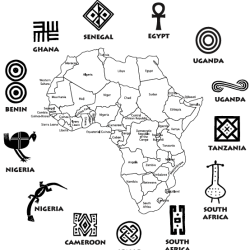Source Institutions
Source Institutions
Add to list Go to activity
Activity link broken? See if it's at the internet archive

In this two-day activity (on pages 16-22), learners use a process like that of the Yoruba people of Nigeria to create an African symbol on cloth. Learners first make cassava gel, then paint decorative symbols on cloth, and finally dye it. Learners examine the significance of symbols in African culture and communication, and the use of natural plant products for human projects.
- 1 to 2 hours
- 1 to 7 days
- $10 - $20 per group of students
- Ages 8 - 14
- Activity
- English, Spanish
Quick Guide
Materials List (per group of students)
- 1 squeeze bottle with cassava gel
- 4 pieces of white paper cut into 20 cm squares
- 4 pieces of white cloth cut into 20 cm squares
- 4 pencils
- masking tape
- 4 cotton swabs
- hair dryer (optional)
- 1 7/8 cups tapioca flour ( also called cassava starch)
- 3 teaspoons alum (powdered ammonium alum)
- pan of 9 cups water
- spoon
- 1 pair disposable gloves
- 4 sponge paint brushes (about 2-3 cm wide)
- newspapers (enough to cover tables with a thick layer)
- 4 plastic spoons
- 1 plastic dish tub half-filled with warm water
- 2 boxes dark blue dye
- 7 plastic widemouth 16. oz. containers
Subjects
-
Engineering and Technology
-
Technology
- Information and Communication
-
Technology
-
Life Sciences
-
Diversity of Life
- Plants
-
Diversity of Life
-
The Nature of Science
-
The Scientific Process
- Communicating Results
-
The Scientific Process
Informal Categories
- Arts and Crafts
Audience
To use this activity, learners need to:
- see
- touch
Learning styles supported:
- Involves teamwork and communication skills
- Links STEM to other topics of interest such as arts and humanities
- Involves hands-on or lab activities
Designed specifically for
- Rural dweller
Culture, ethnicity, and gender
-
Girls
- Explicity developed for this group
Other
Foreign language versions of this resource:
Components that are part of this resource:
Includes alignment to state and/or national standards:
This resource is part of:
Access Rights:
- Free access
By:
Source Collection
- Science After School Consumer's Guide
Rights:
- All rights reserved, University of Nebraska State Museum and Nebraska 4-H, 2001
Funding Sources:
- National Science Foundation Informal Science Education Program, 9909496
- Howard Hughes Medical Institute
